Chouteau Bridge Sidewalk Cracked, Pedestrians Detoured Slightly
The Chouteau bridge (aerial) between 39th and Vandeventer opened on January 19, 2007 (source). The project to replace the old bridge was estimated at $16 million and “the construction contract was awarded to KCI Construction Company for $11.7 million.”
Knowing the bridge wasn’t very old I was surprised recently when I saw barricades on the south edge, then I received a press release from MoDOT:
ST. LOUIS – The Missouri Department of Transportation will close Chouteau Avenue (Route 100) between Vandeventer and Spring in both directions for periods of up to 10 minutes starting at 10 p.m. Tuesday, May 8. All lanes will be open by 6 a.m. Wednesday, May 9.
Crews are conducting load testing on the bridge to determine the best way to fix the sidewalk. The sidewalk has been closed since mid-2011. (MoDOT)
Fix a sidewalk on a five year-old bridge?
BIke/Walk Alert – Chouteau bridge between Vandeventer and 39th St.: During a recent inspection, MODOT found a crack in the sidewalk on the Chouteau Bridge and has closed the sidewalk while they investigate if the bridge is safe. MODOT plans to close one eastbound lane of Chouteau between Vandeventer and 39th and separate it from traffic with a concrete barrier. This lane will be a shared bike and pedestrian path until the sidewalk is repaired. Until the concrete barriers are in place, please use extreme caution when crossing the Chouteau Bridge or select an alternate route. Trailnet will post updates as we become aware of them. (Trailnet Facebook post on November 1, 2011)
With the barriers it’s possible to cross the bridge, although meeting someone in the middle would be a problem.
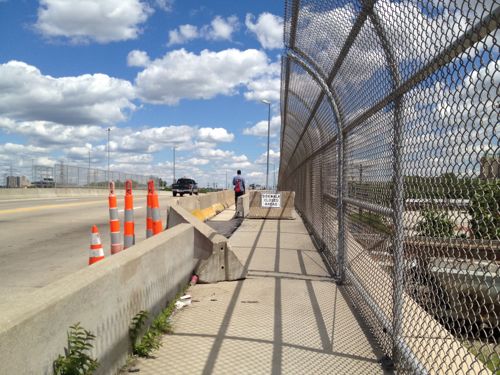
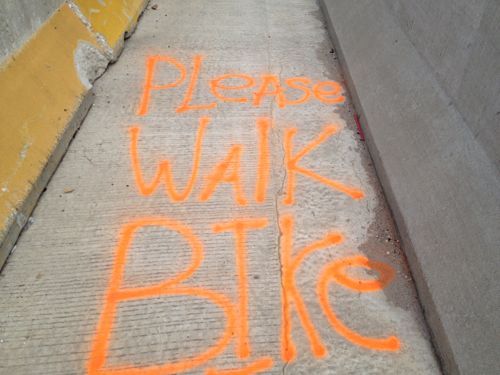
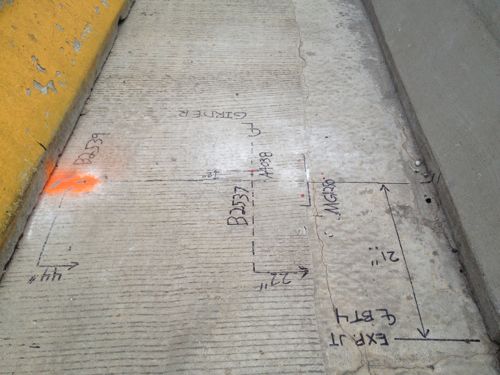
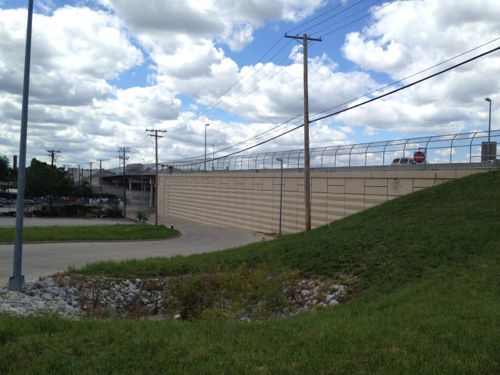
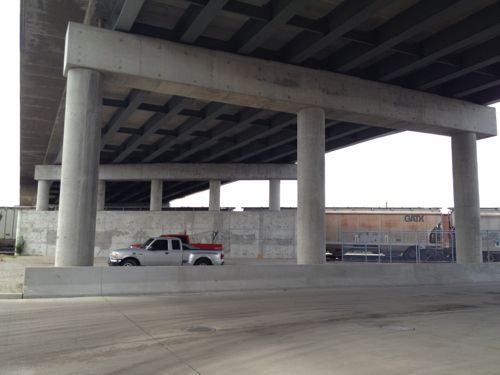
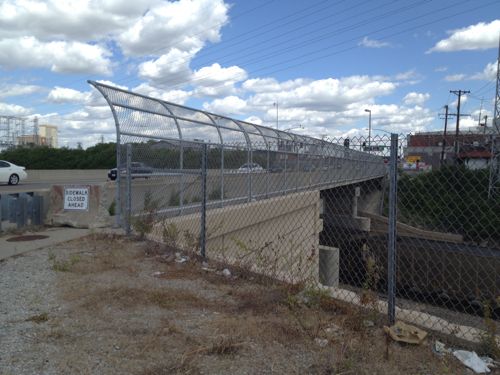
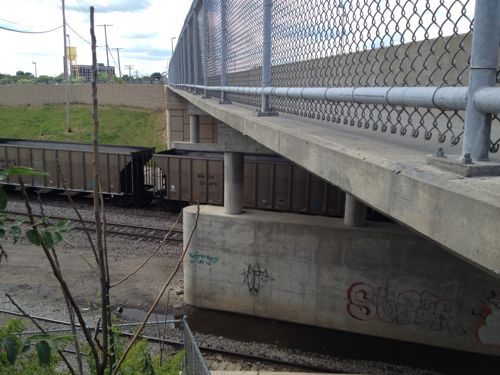
I’ve not seen anything since the recent testing to indicate a solution. MoDOT hasn’t responded to my inquiry. Did Missouri get a warranty on this bridge?
– Steve Patterson
Over the past several weeks/months and next several days, Chouteau bridge engineers will busy themselves reviewing design drawings, shop drawings, original calculations and any x-ray images available in an effort to determine why the inevitable has happened at the Chouteau Bridge. Concrete offers two guarantees: it will (usually) get hard, and it will (usually) crack. But I’ve seen cases where neither has happened!
KCI did offer a one-year warranty. But it probably did not cover cracking. Why? It’s simple! Because concrete cracks.KCI cannot warranty against the inevitable! KCI is one of several experienced St. Louis-based contractors that is familiar with concrete placement procedures, and have religiously followed those prodedures during every concrete pour that I’ve ever worked with them on (several!). They have superintendents who have poured more concrete than most people have walked on during their lifetimes, and it doesn’t behoove them to cut corners….and so they don’t! It just isn’t how they operate.
Why does concrete crack? It can be the result of several factors, including but certainly not limited to thermal contraction, retraint (external and internal) to shortening, subgrade settlement, drying/curing conditions, applied loads, etc. While cracking cannot be prevented, it can be significantly reduced by taking certain precautions when the concrete is poured. So, if the engineering is good, if the weather is good, if the contractor follows industry-standard procedures, if the ready-mix supplier provides the right mix complete with all the chemicals used today in a yard of concrete, if the iron workers placed the rebar correctly, and if the jobsite is lab-perfect and if the weather cooperates…….the concrete is STILL going to crack. You can’t stop it! And you can bet on it!
Oh, and I forgot…… public ‘perception’ is another problem associated with concrete cracking……!
Can poor construction techniques or substandard product also result in concrete cracking? Yes, but it’s more likely that you’ll notice premature surface degradation when contractors have cut corners. Cracking seldom results from poor workmanship. (But it may result from a bad truckload of concrete, but this typically would have been detected right after the pour when the test cylinders were analyzed by the testing lab.)
Typically cracking will occur above embedded items such as reinforcing steel, or when expansion joints are non-continuous, or when cracker joints are omitted.) Some settlement cracking results from insufficient consolidation (vibration), high slumps (too much water, when water/cement ratio is out of whack!), or insufficient concrete cover over embedded items.
Wind, low humidity and high temperatures can also be a factor. Surface moisture evaporates faster than it can be replaced by rising bleed water causing the surface to shrink more than the interior concrete.
Sometimes the structural engineering may be wrong, and the structure won’t support the imposed loads. But with today’s computers and the layers and layers of oversight and opportunites for second reviews, that scenario is unlikely. Engineering failures typically result when an innovative design is introduced. This bridge is a classic bridge design found in Chapter One of any 4th year engineering student’s textbook.
Structural engineers have dealt with cracking concrete for centuries. They have developed alternative design/construction design/placement protocols to try to minimize it (post tensioning is a common example used here in the midwest for parking garages and a few other building types), but it hasn’t solved the problem….and maybe it’s created even a few more! The bottom line is that concrete is going to CRACK.
What can be done? Once the initial design and the field-execution have been reviewed and it has been confirmed that things were done right…..then the crack needs to be addressed. The key is to keep water out of the crack to protect the reinforcing from rusting, which will cause surface rust to expand and the concrete will then begin to crack even more…..further expand and cause major chunks to fall to the ground. So how should it be fixed? Typically the cracks are routed-out, then filled with epoxy or similar material. A traffic deck coating is then applied to the top side, and people can then go about living their lives, being very careful to avoid stepping on the cracks……!
MoDOT like any other owner also has to way the cost of short term warranty as KCI offers or the cost of pursuing longer term warranties to infrastructure that offer a host of issue. For one, KCI would have no control over usage, yes the bridge is design to a specific safety factor and load rating. But how many trucks will actually use over a given period? What will the weather do over a long term, so on Yes, you can reference some historical data but that is the past not the future. Thus, the cost end for a contractor on a long term warranty is simple, you either don’t bid or you put in a lot more money to your bid to cover an unforeseen problem and unknown fix until you have a known condition.
In this case, MoDOT advertised a $16 million dollar job that it got done for under $12 million. The fix might be under a million, concrete cracks as msrdls noted correctly and is a design consideration from the get go. Take the actual cost plus the fix and MoDOT still has a favorable product.
Tpedren: Are we certain that the $16 M budget was for new construction only? Or did it include removal of the old bridge, design and construction administration for the new bridge, commissioning, etc.? IMO, even if MODOT was somehow able to pocket $4+M after all was said and done, they shouldn’t have to spend one extra penny to fix a contractor oversight (if that is found to be the case) or to remedy a faulty design ( IF design was outsourced, and IF the design is found to be at fault).
What I find interesting is that a few, likely minor, cracks in this bridge have resulted in the closure of part of the sidewalk… meanwhile the Kingshighway viaduct is still open, a structure which you can literally watch fall apart every day.
Until the new bridge is thoroughly inspected and all testing is done and a determination is made to confirm if the cracking has any structural significance, engineers are smart to restrict usage on the bridge. I’m certain they’ll look closely at the cantilever. In the case of the Kingshighway viaduct, the deterioration is consistent with historical data, and the concrete deterioration on that structure is an observable and known commodity, predictable and calculable. Therefore, the bridge can be used in its current condition….until such time that engineers feel it’s best to shut it down.
The new bridge-design factors in all the variables that affect its usage and longevity including weather and posted load limits, along with a list of other issues that directly impact the bridge’s integrity. And I’ve never heard of a contractor offering a longer-term warranty beyond contract requirements, for any amount of money.
If a structure is designed and built to industry standards, no extended warranties are necessary. And I repeat: the presence of cracks in any structure is not suggestive of anything beyond the fact that the concrete has….cracks!